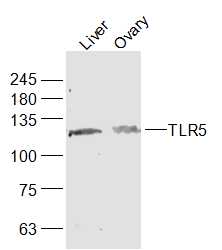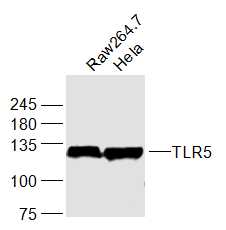
Rabbit Anti-TLR5 antibody
toll-like receptor 5; FLJ10052; MGC126430; MGC126431; TIL 3; TIL3; TLR 5; Toll like receptor 5; Toll like receptor 5 precursor; Toll/interleukin 1 receptor like protein 3;CD285; TLR5_MOUSE.
View History [Clear]
Details
Product Name TLR5 Chinese Name Toll样受体5抗体 Alias toll-like receptor 5; FLJ10052; MGC126430; MGC126431; TIL 3; TIL3; TLR 5; Toll like receptor 5; Toll like receptor 5 precursor; Toll/interleukin 1 receptor like protein 3;CD285; TLR5_MOUSE. literatures Research Area Tumour immunology Signal transduction The cell membrane受体 Bacteria and viruses Immunogen Species Rabbit Clonality Polyclonal React Species Human, Mouse, (predicted: Rat, ) Applications WB=1:500-2000 ELISA=1:5000-10000 IHC-P=1:100-500 (Paraffin sections need antigen repair)
not yet tested in other applications.
optimal dilutions/concentrations should be determined by the end user.Theoretical molecular weight 95kDa Cellular localization The cell membrane Form Liquid Concentration 1mg/ml immunogen KLH conjugated synthetic peptide derived from mouse TLR5: 701-810/873 Lsotype IgG Purification affinity purified by Protein A Buffer Solution 0.01M TBS(pH7.4) with 1% BSA, 0.03% Proclin300 and 50% Glycerol. Storage Shipped at 4℃. Store at -20 °C for one year. Avoid repeated freeze/thaw cycles. Attention This product as supplied is intended for research use only, not for use in human, therapeutic or diagnostic applications. PubMed PubMed Product Detail The Toll like receptor (TLR) family in mammal comprises a family of transmembrane proteins characterized by multiple copies of leucine rich repeats in the extracellular domain and IL1 receptor motif in the cytoplasmic domain. Like its counterparts in Drosophila, TLRs signal through adaptor molecules and could constitute an important and unrecognized component of innate immunity in humans. The TRL family is a phylogenetically conserved mediator of innate immunity that is essential for microbial recognition. TLRs characterized so far activate the MyD88/interleukin 1 receptor-associated kinase (IRAK) signaling pathway. Toll-like receptor 5 (TLR5) expression is upregulated following exposure to bacteria or to the TLR5 agonist, flagellin. Gram-negative bacteria, stimulate monocyte/macrophage cells in a TLR5-specific, CD14-independent manner. The TLR5 receptor thus appears to be the principal means by which the innate immune system recognizes flagellated bacterial pathogens.
Function:
Participates in the innate immune response to microbial agents. Mediates detection of bacterial flagellins. Acts via MYD88 and TRAF6, leading to NF-kappa-B activation, cytokine secretion and the inflammatory response (By similarity).
Subunit:
Homodimer both in the absence and presence of ligand. Binds MYD88 via their respective TIR domains (By similarity).
Subcellular Location:
Membrane; Single-pass type I membrane protein (By similarity).
Tissue Specificity:
Highly expressed in liver. Detected in lung and at very low levels in most other tissues.
Post-translational modifications:
Phosphorylated at Tyr-799 upon flagellin binding; required for signaling (By similarity).
Similarity:
Belongs to the Toll-like receptor family.
Contains 16 LRR (leucine-rich) repeats.
Contains 1 TIR domain.
SWISS:
Q9JLF7
Gene ID:
53791
Database links:Entrez Gene: 7100 Human
Entrez Gene: 53791 Mouse
Omim: 603031 Human
SwissProt: O60602 Human
SwissProt: Q9JLF7 Mouse
Unigene: 604542 Human
Unigene: 116894 Mouse
Toll样受体5可在单核细胞、未成熟树突状细胞及epithelial cells表达 ,可能是一种参与免疫应答的受体 ,其具体作用尚不清楚。
TLR5可辨认鞭毛蛋白(fla-gellin),此种蛋白可组成鞭毛,与细菌泳动有关.Product Picture
Liver (Mouse) Lysate at 40 ug
Ovary (Mouse) Lysate at 40 ug
Primary: Anti-TLR5 (SL1197R) at 1/1000 dilution
Secondary: IRDye800CW Goat Anti-Rabbit IgG at 1/20000 dilution
Predicted band size: 95 kD
Observed band size: 130 kD
Bought notes(bought amounts latest0)
No one bought this product
User Comment(Total0User Comment Num)
- No comment




 +86 571 56623320
+86 571 56623320
 +86 18668110335
+86 18668110335

